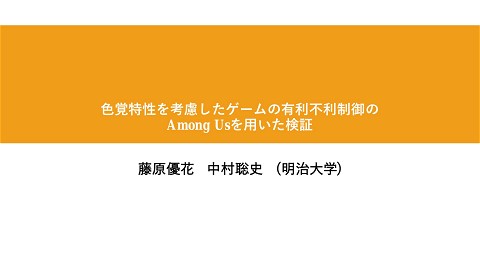Validation of Game Advantage Disadvantage Control Considering Color Vision Characteristics: A Basic Study on Among Us with Different Color Settings
851 Views
September 08, 23
スライド概要
明治大学 総合数理学部 先端メディアサイエンス学科 中村聡史研究室
関連スライド
各ページのテキスト
Validation of Game Advantage Disadvantage Control Considering Color Vision Characteristics: A Basic Study on “Among Us” with Different Color Settings Tohya Aokia, Yuka Fujiwaraa, Satoshi Nakamuraa, a Meiji University, 4-21-1 Nakano, Nakano-ku, Tokyo 164-8525, Japan
Background • Many people enjoy playing online internet games, but some people have trouble with their handicaps • Handicaps put people at a disadvantage in aspects other than game skills The victory and the loss of the game would be affected by the non-technical aspects
Background • There are many types of handicaps In this study, we will focus on color vision diversity
Color Vision Diversity Normal color vision P-type color vision R Pi Pu LB R Pi Pu LB B G Y Or B G Y Or D-type color vision T-type color vision R Pi Pu LB R Pi Pu LB B G Y Or B G Y Or
Color Vision Diversity Japanese male with color vision diversity
Color Vision Diversity Japanese male with color vision diversity 1 in 20 Japanese male 1 in 500 Japanese female
Color Vision Diversity Green and Yellow Yellow only Difficult to make decisions by the colors
Color Vision Diversity • Players with color vision diversity have difficulties making decisions by the color • Reaction speed would be later than normal vision players • Shorter time to move from decision to action, the more advantageous it becomes • Game companies take measures to address this problem by color vision support
Color Vision Support Normal color vision mode P-type color vision mode
Goal of our Study
Main Purpose Eliminate color handicaps for color vision diverse players with various characteristics when playing games
Our Past Study [ICEC 2021] without filter
Our Past Study [ICEC 2021] Advantageous for normal vision Color pairs target Advantageous for D-type vision Actual colors With D-type filter basic target basic Color pairs target Disadvantageous for D-type vision Actual colors With D-type filter basic target basic Disadvantageous for normal vision
Real-time Color Conversion System P-type color vision D-type color vision The color they see differs by their type
Real-time Color Conversion System To eliminate color handicaps we need to gather all the types of color vision diversity It is difficult to gather many color vision diversity people Present the colors that the D-type color vision diversity people see to the normal color vision people
Real-time Color Conversion System Color conversion procedure for filters used in the experiment
Real-time Color Conversion System Without filter (Normal color vision) With filter (D-type color vision)
Purpose of our Study In past studies, we investigated the colors that could be identified easily BUT It is unknown if advantage/disadvantage control is possible in the actual game Verify using Among Us
Purpose of our Study Investigate the possibility of controlling game advantages and disadvantages based on color vision characteristics using actual games
Among Us Why Among Us? Without filter (Normal color vision) With filter (D-type color vision)
Among Us Why Among Us? the color scheme can be set according to the findings of past research
Among Us VS
Among Us The victory conditions for the crews The victory conditions for the impostors Complete all onboard tasks Kill the crews until their number becomes the same as the number of the impostors OR OR Eliminate all of the impostors Obstruct the crew's escape
Among Us Discussion phase Work phase Colors are important to judge the players
Experiment Summary • Experiment using Among Us(Total 4 games) • 10 male experiment participants - Plays online games regularly - 4 in 10 participants were the with filter group • Color of the players were random • Player’s name fixed to 4 Hiragana characters
Hypothesis • Hypothesis1: Overall, characters of easily identifiable colors will be more conversational in the discussion phase than characters of less identifiable colors • Hypothesis2: Overall, characters of easily identifiable colors, for example white, will have less variation in color representation in the discussion phase than the characters of less identifiable colors • Hypothesis3: In the task focusing on the colors, tasks with less discriminative colors will take longer to complete than tasks with more discriminative colors
Hypothesis Task focusing on colors
Result Average time and mistakes of the wire connection task The without filter group finished the task faster
Result Average time and mistakes of the wire connection task Only the with filter group made a mistake
Result Percentage of the number of color names spoken to the total number of conversations
Result Percentage of the number of color names spoken to the total number of conversations The with filter group spoked less than the without filter group
Result Only the with filter group made a mistake during the wire connection task Without filter (Normal color vision) With filter (D-type color vision)
Result Can identify each colors easily Red and Yellow, Pink and Blue are identical Without filter (Normal color vision) With filter (D-type color vision)
Result Can identify each colors easily Red and Yellow, Pink and Blue are identical When there are colors difficult to identify, it will be a disadvantageous situation Without filter (Normal color vision) With filter (D-type color vision)
Result
Result Orange(with filter) was killed with filter without filter without filter without filter
Result 5 people were around the corpse a discussion of who was there White, pink, and maroon were there with filter I don’t think pink was there Some colors were identified easier with the filter without filter
Discussion Colors that were difficult to distinguish from one to another with filter group without filter group
Discussion • Hypothesis1: Overall, characters of easily identifiable colors will be more conversational in the discussion phase than characters of less identifiable colors →was partially supported • Hypothesis2: Overall, characters of easily identifiable colors, for example white, will have less variation in color representation in the discussion phase than the characters of less identifiable colors →was partially supported • Hypothesis3: In the task focusing on the colors, tasks with less discriminative colors will take longer to complete than tasks with more discriminative colors →was supported
Contribution • Purple and Blue were difficult to identify in both conditions →can reduce visibility for both groups • White was easily identified in both conditions, no matter which colors it was paired with →a color that can be used reliably for color vision support Can be used as a guideline in design of color vision support
Prospects • Experiment was insufficient to test the hypothesis →There was a color bias in the impostor’s color • The number of experiments was small →next time we plan on making a long-term experiment • It was impossible to verify statistically →plan on using a game that allows comparison between players in terms of scores next time
Other Games ©2018 SEGA Puyo Pop
Other Games ©2022 VALORANT
Conclusion Purpose: Investigation of a color that can be used as an indicator to control advantages and disadvantages due to color vision Experiment: Play Among Us while mixing the two groups using and not using color transformation filters Results: It is possible to control advantages and disadvantages depending on the color scheme





